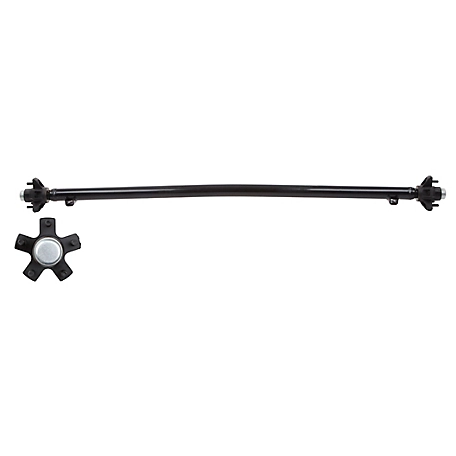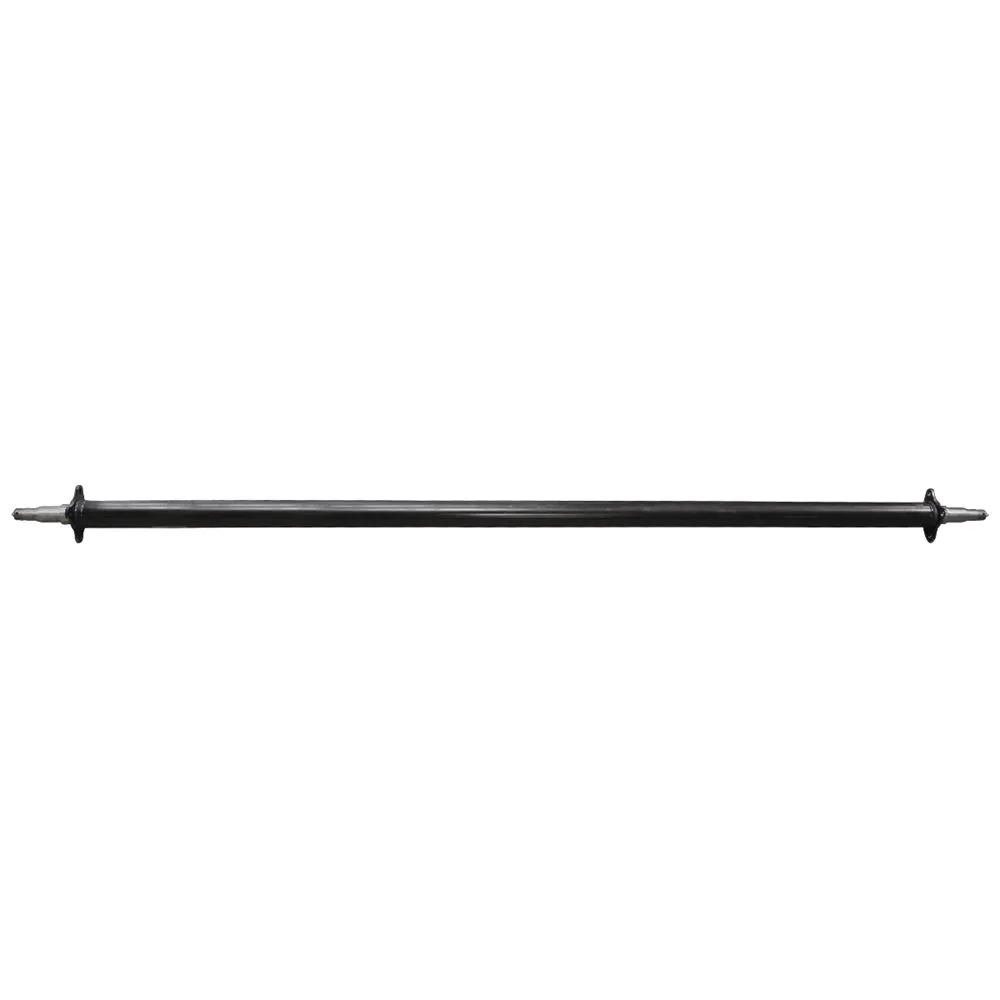Product Description
Product Description
Product Parameters
| Specification | Data |
| Rated axle load(KG) | 2×16000 |
| Track(MM) | 1860 |
| Section size(MM) | 169x166x19 |
| Driven gear reference circle dia.(MM) | Dia469 |
| Flange(MM) | Serration ISO8667-T180 |
| Max input torque | F.R.axle 27150 26490 25510 21580 18640 15700 R.R alxe 18660 17660 16680 14710 11770 9810 |
| Transmission rate | 3.866 4.769 (3.2) 5.262 5.920 6.733 7.630 8.880 (3.947) |
| Brake size | Dia410x220 |
| Brake distributor pump(In) | 24″/24″ |
| Braking torque(Nm) | 40300/55300 |
| Axle weight(Kg) | 950/840 |
| Wheel pilot | Wheel bolt 10-M22x1.5, reference circle dia.335 |
Certifications
Company Profile
ZheJiang Lide Auto Technology Co., Ltd., founded in 1996, is a professional manufacturer of trailer axle assemblies and semi-trailer suspension systems in China. We are located in HangZhou, the famous scenic city. We are 1 of specialized enterprises in the scientific research, design, production and sale, with more than 600 skilled employees and professional designers for different areas. We adopt the domestic and international technical standards in production, accurately grasp the information of the market demand and make quick and optimal designs. In this way, our axle, suspension and other fittings have the world-class technical quality through reasonable and advanced manufacture technologies. Our advanced processing technology, first-class production line and precision CNC machining equipment from home and abroad ensure the good quality of our semi-trailer axle assemblies, suspension systems and other correlative fittings. At the same time, our annual capacity for the export of American and German semi-trailer axle assemblies has achieved 60, 000 pieces . We obtained the ISO9001: 2000 International Quality Management System Certification in 2003 and TS16949 Certification in 2007. “First-class product quality, the meticulous and thoughtful service, and CZPT cooperation” is the philosophy that we always cherish. We not only meet the domestic market demand, but also export our products to Southeast Asia, the Middle East, Latin America and other countries, enjoying a good reputation.
/* January 22, 2571 19:08:37 */!function(){function s(e,r){var a,o={};try{e&&e.split(“,”).forEach(function(e,t){e&&(a=e.match(/(.*?):(.*)$/))&&1
| After-sales Service: | 3 Year |
|---|---|
| Condition: | New |
| Axle Number: | 1 |
| Samples: |
US$ 100/Piece
1 Piece(Min.Order) | Order Sample |
|---|
| Customization: |
Available
| Customized Request |
|---|
.shipping-cost-tm .tm-status-off{background: none;padding:0;color: #1470cc}
| Shipping Cost:
Estimated freight per unit. |
about shipping cost and estimated delivery time. |
|---|
| Payment Method: |
|
|---|---|
|
Initial Payment Full Payment |
| Currency: | US$ |
|---|
| Return&refunds: | You can apply for a refund up to 30 days after receipt of the products. |
|---|

Can you provide examples of common trailer types that use different axles?
Certainly, various types of trailers use different axles to meet their specific needs:
- Utility Trailers: Smaller utility trailers often use single axles for lighter loads, while larger ones may have tandem axles for increased capacity.
- Boat Trailers: Boat trailers may feature multiple axles to support the weight of different-sized boats.
- Travel Trailers: Travel trailers come in various sizes, each with axles suitable for their weight and towing requirements.
- Horse Trailers: Depending on the number of horses they carry, horse trailers use single or multiple axles with features for animal safety.
- Cargo Trailers: Cargo trailers range from smaller single-axle versions to larger tandem or multi-axle trailers for transporting goods.
- Flatbed Trailers: These trailers for heavy loads feature tandem or multi-axle configurations to support oversized cargo.
- Dump Trailers: Trailers used for frequent dumping of materials come with robust axles designed for heavy use.
- Refrigerated Trailers: Reefer trailers use axles suitable for both the weight of goods and the requirements of refrigeration systems.
- Specialty Trailers: Car haulers, concession trailers, and equipment trailers come with axles tailored to their specific purposes and loads.
In summary, the choice of axles depends on the trailer type and its intended use, load capacity, and towing requirements.

What are the key considerations when selecting the right trailer axle for a specific application?
Choosing the appropriate trailer axle for a specific application involves several critical considerations:
- Weight Capacity: Determine the maximum weight the axle will need to support. This includes the trailer’s payload and the weight of the trailer itself. Ensure the selected axle has a weight capacity that exceeds the application’s requirements to provide a safety margin.
- Axle Type: Select the axle type based on the application. Common types include straight axles, drop axles, and torsion axles. The choice depends on factors like ground clearance, load height, and suspension design.
- Axle Configuration: Decide on the number of axles needed. Single axles are suitable for lighter loads, while tandem and tri-axle configurations offer higher weight capacities. Multi-axle setups provide better weight distribution.
- Suspension Type: Choose the appropriate suspension system, such as leaf spring, air ride, or torsion suspension. The suspension affects ride quality, load stability, and maintenance requirements.
- Brake System: Consider the braking requirements. Larger and heavier trailers often require electric or hydraulic brakes. Ensure the axle accommodates the necessary brake system, including the brake size and type.
- Axle Material: Select the axle material, typically steel or aluminum. Steel axles are durable and cost-effective, while aluminum axles are lighter and corrosion-resistant. The choice depends on the application’s demands and budget.
- Hub and Spindle Type: Choose hubs and spindles compatible with the axle. The hub style affects the type of wheel and tire you can use, while spindle size impacts weight capacity and bearing compatibility.
- Wheel Bolt Pattern: Ensure the axle’s hub and wheel bolt patterns match to avoid compatibility issues with the wheels and tires you plan to use.
- Ground Clearance: Consider the required ground clearance for the application. Lower ground clearance may be suitable for highway travel, while off-road or specialty trailers may need increased clearance.
- Legal Compliance: Ensure that the selected axle and trailer configuration comply with local and national regulations regarding weight limits, axle spacing, and safety requirements.
- Manufacturer and Warranty: Choose a reputable axle manufacturer with a track record for quality and durability. Check the warranty and support offered by the manufacturer.
- Budget: Evaluate the budget constraints for the axle and select an option that balances cost-effectiveness with meeting the application’s needs.
By carefully considering these factors, you can select the right trailer axle that ensures safe and efficient performance for your specific application.

How does the placement of trailer axles affect weight distribution and towing?
The placement of trailer axles plays a crucial role in weight distribution and towing characteristics. There are two primary axle configurations: single axle and tandem axle, each with distinct effects:
1. Single Axle Trailers:
– Single axle trailers have only one axle positioned toward the rear of the trailer. This configuration is common in smaller utility and light-duty trailers.
– Weight Distribution: With a single axle, more of the trailer’s weight is concentrated toward the rear. This can lead to inadequate weight distribution and make the trailer prone to swaying or fishtailing during towing.
– Towing Characteristics: Single axle trailers are generally easier to maneuver and tow, making them suitable for smaller loads and shorter trips. However, they may lack stability with heavier loads.
2. Tandem Axle Trailers:
– Tandem axle trailers feature two axles placed closer together, typically with one in front of the other. This design is commonly found in larger trailers and offers several advantages.
– Weight Distribution: Tandem axles distribute the trailer’s weight more evenly. This improves stability and reduces the risk of swaying. The weight is better balanced between the axles, leading to improved control during towing.
– Towing Characteristics: Tandem axle trailers are more stable and capable of handling heavier loads. They are less prone to sway, making them suitable for long-distance hauling and larger cargo.
– Additional Features: Tandem axle trailers may have braking systems, which further enhance safety and control during towing, especially when towing heavier loads.
– Considerations: It’s important to note that the placement of axles within a trailer also affects the tongue weight (the downward force on the hitch). Proper tongue weight is essential for safe towing, and it can be adjusted by positioning the cargo within the trailer.
– Ultimately, the choice between single and tandem axles depends on the trailer’s intended use and the weight of the cargo. Tandem axle trailers are preferred for heavier loads and long-distance towing, while single axle trailers are suitable for smaller, lighter loads and shorter trips. Proper weight distribution and adherence to safety guidelines are critical for safe and stable towing.


editor by CX 2024-03-07
Leave a Reply